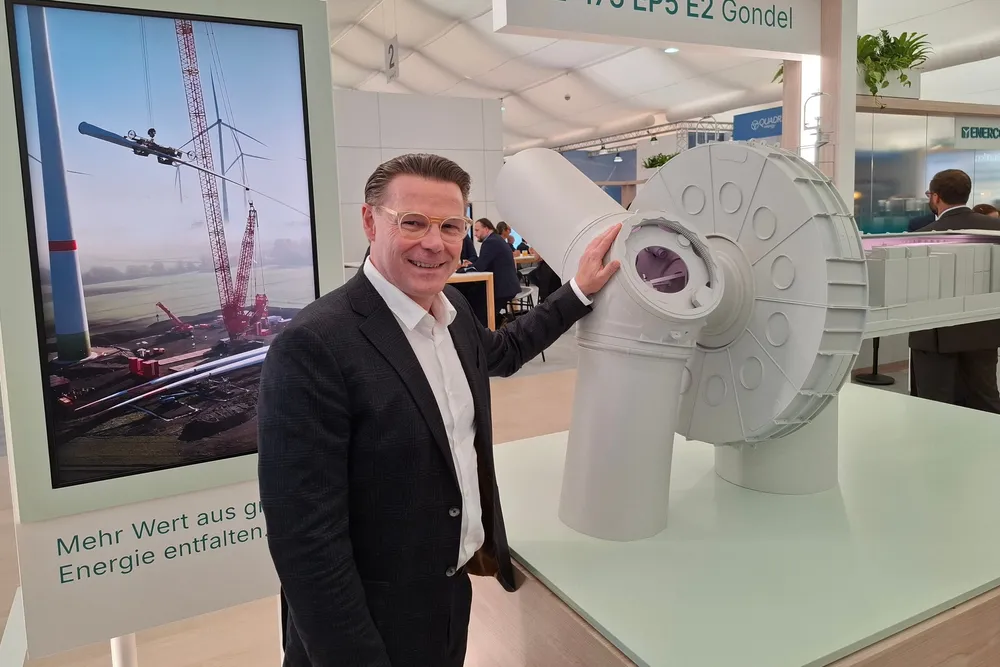Enercon CEO's recipe for profitability in a post-subsidy wind market
As German turbine manufacturer is close to breaking even, it changes strategy to customer-oriented 'holistic' approach that eyes entire energy system with wind at its core

The new CEO used the dire situation to undertake some soul-searching to find out not only what the company needed to get out of the red, but also how it must be set up in the future to cater for a changing energy and support system.
Enercon started with an analysis of how it expected markets to look in 2030, and which strategy to apply going forward.
“The idea was to come back to become a four to five-gigawatt company” – referring to the volume of turbines it would aim to sell annually – as a mid-term target, Bauer added.
Fix the basics
To achieve that, the team around Bauer came up with a three-pillar strategy.
The first was to fix the basics. This included reducing the myriad number of organisations and legal entities within or associated with Enercon. Many were either shed or brought together to share “one Enercon mindset going forward”.
The machine comes with a split generator to facilitate transport in densely populated countries like Germany, the Netherlands and the UK.
Enercon, at the same time, has reduced its product portfolio and no longer offers turbines in the 3MW-class.
While Bauer admits that the company still has a “huge ramp-up in front of us” for the E-175-EP5 models, he said “we are coming back into the territory where we're making money” with a product “asked for by customers”.
Hybrids, storage, grid integration
For profit to be more lasting and also survive in a rapidly changing energy system and regulatory regimes, Enercon carried out an in-depth analysis of what kind of portfolio will be needed in the future.
“This is not related to a new machine. It's related to the needs of the market,” Bauer said.
“We worked strategically with key customers, and broke down what kind of changes they see in the market, and what kind of offerings they need in the future.”
Instead of Enercon’s traditional approach to offer the best possible technology in wind turbines, plus a wide-ranging service, the company now puts the customer centre-stage.
“In the past, Enercon looked first at the product, then at the customer. This has completely changed,” Bauer said, adding the company now was “completely customer-orientated” and is “holistically” looking at the whole power system “end-to-end”.
Close to energy minister’s ideas
Reiche has also repeatedly said Germany’s Energiewende – its transition from nuclear and fossil fuels to renewable energy – must be carried out in a way that reflects overall system costs, and not just the cost of a single facility such as a wind farm.
Bauer said he had written Reiche a letter, but the energy minister has so far not reacted to it.
While Enercon is aware that many of its suggestions fit right into Reiche’s ideas, the company had actually been brewing over its new strategy for much longer. Already when the previous – and much more renewables-friendly – government was in its last phase, Enercon analysed what changes both the energy and renewables support system are likely to undergo.
Away from ‘price, price, price’
“We want to go away from that classical LCOE (levelised cost of energy) approach that means price, price, price,” Bauer said, and “we want to go for the optimised value of energy.”
Not just in Germany, but in many other key markets, governments are moving away from feed-in tariffs (FITs) or other forms of state support towards freer markets where different requirements are needed and power producers themselves are responsible for marketing their output, he reckons.
“We see this as an opportunity,” Bauer said, also as Enercon is trying to increasingly widen its customer base from small and mid-sized clients towards larger utilities and industrial customers who buy wind power through long-term power purchase agreements (PPAs).
While PPAs have been common for parts of the power output of offshore wind, the PPA market in onshore wind still has much room to grow.
“Going forward, we see industrial customers coming more and more,” Bauer said.
Watching the Chinese
Working with clients on a more holistic approach that takes the cost of the entire energy system into account is also useful when dealing with increased competition from Chinese rivals, the CEO thinks.
“The Chinese have also emphasised going for the European market, and we have to watch them very closely,” Bauer said.
“But they will come, no doubt about it. We see them from the outer territory, coming into the core markets, where we are. It is a competition we have to face.”
His company will “not be shying back” from bidding also in future Turkish wind power tenders and sees continued good chances there due to Enercon’s close cooperation with customers in the country, Bauer said.
Being “close to our customers” and offering decades of a wide-ranging service in key markets such as Germany or Turkey will help Enercon keep many of its clients there, even if cheap Chinese competitors advance.
But Bauer acknowledged that Chinese OEMs are also serious competitors in Latin American, African and Asian markets, where the company doesn’t always have such a dense service network.
(Copyright)